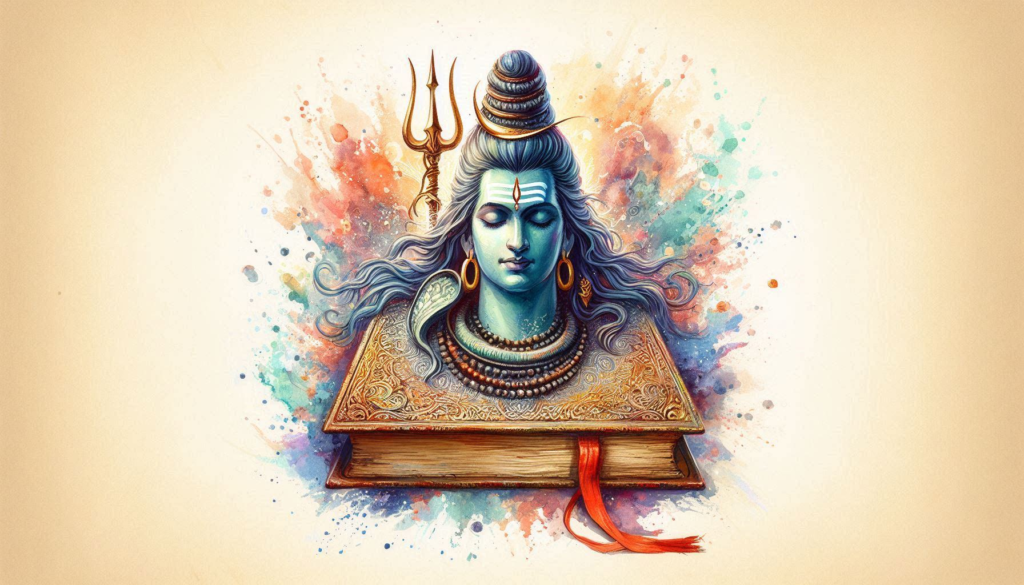Shiv Chalisa
The Shiv Chalisa is a devotional hymn consisting of 40 verses dedicated to Lord Shiva, one of the principal deities in Hinduism. Lord Shiva, known as the destroyer in the Hindu trinity, is revered as the supreme being who embodies both asceticism and compassion. The Shiv Chalisa is widely recited by devotees, particularly during auspicious occasions like Maha Shivaratri, Shravan Maas and on Mondays, which are considered sacred to Lord Shiva.

Shri Shiv Chalisa
Doha
Jai Ganesha Girija Suvana,Mangala Mula Sujana।
Kahata Ayodhyadasa Tuma,Dehu Abhaya Varadana॥
Chaupai
Jai Girija Pati Dinadayala।Sada Karata Santana Pratipala॥
Bhala Chandrama Sohata Nike।Kanana Kundala Nagaphani Ke॥
Anga Gaura Shira Ganga Bahaye।Mundamala Tana Chhara Lagaye॥
Vastra Khala Baghambara Sohe।Chhavi Ko Dekha Naga Mana Mohe॥
Maina Matu Ki Have Dulari।Bama Anga Sohata Chhavi Nyari॥
Kara Trishula Sohata Chhavi Bhari।Karata Sada Shatruna Kshayakari॥
Nandi Ganesha Sohain Tahan Kaise।Sagara Madhya Kamala Hain Jaise॥
Kartika Shyama Aura Ganarau।Ya Chhavi Ko Kahi Jata Na Kau॥
Devana Jabahi Jaya Pukara।Tabahi Dukha Prabhu Apa Nivara॥
Kiya Upadrava Taraka Bhari।Devana Saba Mili Tumahin Juhari॥
Turata Shadanana Apa Pathayau।Luvanimesha Mahan Mari Girayau॥
Apa Jalandhara Asura Sanhara।Suyasha Tumhara Vidita Sansara॥
Tripurasura Sana Yudha Machai।Sabhin Kripakara Lina Bachai॥
Kiya Tapahin Bhagiratha Bhari।Puraba Pratigya Tasu Purari॥
Danina Mahan Tuma Sama Kou Nahin।Sevaka Stuti Karata Sadahin॥
Veda Mahi Mahima Tuma Gai।Akatha Anandi Bheda Nahin Pai॥
Prakati Udadhi Manthana Mein Jwala।Jarata Surasura Bhae Bihala॥
Kinhi Daya Tahan Kari Sahai।Nilakantha Taba Nama Kahai॥
Pujana Ramachandra Jaba Kinha।Jita Ke Lanka Vibhishana Dinha॥
Sahasa Kamala Mein Ho Rahe Dhari।Kinha Pariksha Tabahin Purari॥
Eka Kamala Prabhu Rakheu Joi।Kamala Nayana Pujana Chahan Soi॥
Kathina Bhakti Dekhi Prabhu Shankara।Bhae Prasanna Diye Ichchhita Vara॥
Jai Jai Jai Ananta Avinashi।Karata Kripa Sabake Ghatavasi॥
Dushta Sakala Nita Mohi Satavai।Bhramata Rahaun Mohi Chaina Na Avai॥
Trahi Trahi Main Natha Pukaro।Yahi Avasara Mohi Ana Ubaro॥
Lai Trishula Shatruna Ko Maro।Sankata Te Mohi Ana Ubaro॥
Mata Pita Bhrata Saba Hoi।Sankata Mein Puchhata Nahin Koi॥
Swami Eka Hai Asha Tumhari।Aya Harahu Mama Sankata Bhari॥
Dhana Nirdhana Ko Deta Sada Hin।Jo Koi Janche So Phala Pahin॥
Astuti Kehi Vidhi Karai Tumhari।Kshamahu Natha Aba Chuka Hamari॥
Shankara Ho Sankata Ke Nashana।Mangala Karana Vighna Vinashana॥
Yogi Yati Muni Dhyana Lagavain।Sharada Narada Shisha Navavain॥
Namo Namo Jai Namah Shivaya।Sura Brahmadika Para Na Paya॥
Jo Yaha Patha Karai Mana Lai।Ta Para Hota Hai Shambhu Sahai॥
Riniyan Jo Koi Ho Adhikari।Patha Kare So Pavana Hari॥
Putra Hona Kara Ichchha Koi।Nishchaya Shiva Prasada Tehi Hoi॥
Pandita Trayodashi Ko Lave।Dhyana Purvaka Homa Karavai॥
Trayodashi Vrata Karai Hamesha।Take Tana Nahin Rahai Kalesha॥
Dhupa Dipa Naivedya Chadhave।Shankara Sammukha Patha Sunave॥
Janma Janma Ke Papa Nasave।Anta Dhama Shivapura Mein Pave॥
Kahain Ayodhyadasa Asa Tumhari।Jani Sakala Duhkha Harahu Hamari॥
Doha
Nitta Nema Uthi Pratah Hi,Patha Karo Chalisa।
Tuma Meri Manakamana,Purna Karo Jagadisha॥
Magasira Chhathi Hemanta Ritu,Samvata Chausatha Jana।
Stuti Chalisa Shivahi,Purna Kina Kalyana॥
Themes and Content of Shiv Chalisa
The Shiv Chalisa encapsulates various aspects of Lord Shiva’s divine persona, mythology, and philosophical significance. Below are the key themes:
Praise of Shiva’s Divine Attributes
- The Chalisa glorifies Shiva as Mahadev , Bholenath , and Neelkanth (the blue-throated one, due to consuming poison during the churning of the ocean).
- It describes his physical appearance: matted hair adorned with the Ganga river, a crescent moon on his forehead, serpents around his neck, and his body covered in ashes.
- Shiva is depicted as both a fierce destroyer and a compassionate protector who grants boons to his devotees.
- The hymn recounts key stories from Shiva’s mythology, such as:
- Churning of the Ocean (Samudra Manthan): Shiva drinking the poison Halahal to save the universe, earning the name Neelkanth.
- Destruction of Tripurasura: Shiva’s victory over the three demon cities.
- Marriage to Parvati: His divine union with Goddess Parvati, symbolizing the balance of masculine and feminine energies.
- It also mentions his role as the eternal yogi meditating on Mount Kailash and his association with the Nandi bull, his divine vehicle.
Spiritual and Philosophical Significance
- The Chalisa emphasizes Shiva as the embodiment of detachment and meditation, inspiring devotees to renounce material desires and seek spiritual enlightenment.
- It portrays Shiva as the destroyer of ignorance and the granter of moksha (liberation from the cycle of birth and death).
- The hymn underscores the importance of devotion (bhakti) and surrender to Shiva to overcome life’s challenges.
Benefits of Recitation
- The closing verses highlight the spiritual and material benefits of chanting the Chalisa, including:
- Removal of fear, sins, and obstacles.
- Attainment of peace, prosperity, and divine protection.
- Fulfillment of desires and spiritual awakening.
How to Recite Shiv Chalisa
To recite the Shiv Chalisa with reverence, devotees typically follow these steps:
- Preparation:
- Take a bath to purify the body and mind.
- Set up a small altar with an image or idol of Lord Shiva, a Shiva Lingam, or a picture of his family (Parvati, Ganesha, Kartikeya).
- Light a diya (oil lamp) and incense sticks, and offer flowers, bilva leaves (sacred to Shiva), and water.
- Recitation:
- Sit facing east or north, ideally in a calm and quiet environment.
- Begin with an invocation to Lord Ganesha (to remove obstacles) and then chant the Shiv Chalisa.
- Recite the verses slowly, with focus and devotion, understanding their meaning for deeper connection.
- Some devotees chant it 11, 21, or 108 times for amplified spiritual benefits.
- Post-Recitation:
- Offer prasad (sacred food) like milk, curd, or sweets.
- Conclude with the Shiva Aarti (e.g., “Om Jai Shiv Omkara”) and prayers for blessings.
- Distribute prasad among family or devotees.



